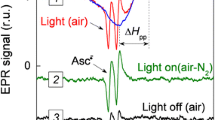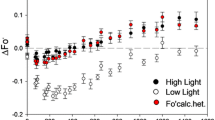Abstract
The presence of an acidic lumen and the xanthophylls, zeaxanthin and antheraxanthin, are minimal requirements for induction of non-radiative dissipation of energy in the pigment bed of Photosystem II. We recently reported that ascorbate, which is required for formation for these xanthophylls, also can mediate the needed lumen acidity through the Mehler-peroxidase reaction [Neubauer and Yamamoto (1992) Plant Physiol 99: 1354–1361]. It is demonstrated that in non-CO2-fixing intact chloroplasts and thylakoids of Lactuca sativa, L. c.v. Romaine, the ascorbate available to support de-epoxidase activity is influenced by membrane barriers and the ascorbate-consuming Mehler-peroxidase reaction. In intact chloroplasts, this results in biphasic kinetic behavior for light-induced de-epoxidation. The initial relatively high activity is due to ascorbate preloaded into the thylakoid before light-induction and the terminal low activity due to limiting ascorbate from the effects of chloroplast membranes barriers and a light-dependent process. A five-fold difference between the initial and final activities was observed for light-induced de-epoxidation in chloroplasts pre-incubated with 120 mM ascorbate for 40 min. The light-dependent activity is ascribed to the competitive use of ascorbic acid by ascorbate peroxidase in the Mehler-peroxidase reaction. Thus, stimulating ascorbic peroxidase with H2O2 transiently inhibited de-epoxidase activity and concomitantly increased photochemical quenching. Also, the effects inhibiting ascorbate peroxidase with KCN, and the KM values for ascorbate peroxidase and violaxanthin de-epoxidase of 0.36 and 3.1 mM, respectively, support this conclusion. These results indicate that regulation of xanthophyll-dependent non-radiative energy dissipation in the pigment bed of Photosystem II is modulated not only by lumen acidification but also by ascorbate availability.
Similar content being viewed by others
Abbreviations
- APO:
-
ascorbate peroxidase
- MP:
-
Mehler ascorbate-peroxidase
- NIG:
-
nigericin
- NPQ:
-
non-photochemical quenching
- Fo :
-
dark fluorescence
- F:
-
fluorescence at any time
- FM :
-
maximal fluorescence of the (dark) non-energized state
- F′M :
-
maximal fluorescence of the energized state
- qP :
-
coefficient for photochemical fluorescence quenching
- VDE:
-
violaxanthin de-epoxidase
- k :
-
first-order rate constant for violaxanthin de-epoxidase activity
References
Anderson, JW, Foyer, CH and Walker, DA (1983) Light-dependent reduction of dehydroascorbate and uptake of exogenous ascorbate by spinach chloroplasts. Planta 158: 442–450
Aristarkhov, A, Nikandrov, VV and Krasnovskii, AA (1988) Ascorbate permeability of chloroplast thylakoid membrane, reduction of plastoquinones and cytochrome f. Biorak 577.23: 1776–1784 (translated from Biokhimiya 52: 2051–2060, 1987)
Asada, K (1992) Production and scavenging of active oxygen in chloroplasts. In: Scandalios, JG (ed) Molecular Biology of Free Radical Scavenging Systems, pp 173–192. Cold Spring Harbor Lab Press, New York
Asada, K and Badger, M (1984) Production of 18O2 and H2 18O2 with concomitant evolution of 16O2 in spinach chloroplasts: Evidence for scavenging hydrogen peroxide by peroxidase. Plant Cell Physiol 25(7): 1169–1179
Asada, K and Takahashi, M (1987) Production and scavenging of active oxygen in photosynthesis. In: Kyle, DJ, Osmond, CB and Arntzen, CJ (eds) Photoinhibition, pp 227–287. Elsevier Science Publishers, Amsterdam
Beck, E, Burkert, A and Hofmann, M (1983) Uptake of L-ascorbate by intact spinach chloroplasts. Plant Physiol 73: 41–45
Briantais, J-M, Vernotte, C, Picaud, M, Krause, GH and Weis, E (1979) A quantitative study of the slow decline of chlorophyll a fluorescence in isolated chloroplasts. Biochim Biophys Acta 548: 128–138
Chen, G-X and Asada, K (1989) Ascorbate peroxidase in tea leaves: Occurrence of two isozymes and the differences in their enzymatic and molecular properties. Plant Cell Physiol 30: 987–998
Demmig, B, Winter, K, Krüger, A and Cygan, F-C (1988) Zeaxanthin and the heat dissipation of excess light energy in Nerium oleander exposed to a combination of light and water stress. Plant Physiol 87: 17–24
Demmig-Adams, B (1990) Carotenoids and photoprotection in plants. A role for the xanthophyll zeaxanthin. Biochim Biophys Acta 1020: 1–24
Demmig-Adams, B and Adams, WW (1992a) Photoprotection and other responses of plants to high light stress. Ann Rev Plant Physiol Plant Mol Biol 43: 599–626
Demmig-Adams, B and Adams, WW (1992b) Carotenoid composition in sun and shade leaves of plants with different life forms. Plant Cell Environ 15: 411–419
Demmig-Adams, B, Winter, K, Krüger, A and Czygan, F-C (1989) Light responses of CO2 assimilation, dissipation of excess excitation energy, and zeaxanthin content of sun and shade leaves. Plant Physiol 90: 881–886
Foyer, CH, Rowell, J and Walker, D (1983) Measurement of the ascorbate content of spinach leaf protoplasts and chloroplasts during illumination. Planta 157: 239–244
Foyer, CH, Dujardin, M and Lemoine, Y (1989) Responses of photosynthesis and the xanthophyll and ascorbate-glutathione cycles to changes in irradiance, photoinhibition and recovery. Plant Physiol Biochem 27: 751–760
Foyer, C, Furbank, R, Harbinson, J and Horton, P (1990) The mechanisms contributing to photosynthetic control of electron transport by carbon assimilation in leaves. Photosynth Res 25: 83–100
Gerbling, KP, Kelly, GJ, Fischer, KH and Latzko, E (1984) Partial purification and properties of soluble ascorbate peroxidase from tea leaves. J Plant Physol 115: 59–67
Gillham, DJ and Dodge, AD (1986) Hydrogen-peroxide-scavenging systems within pea chloroplasts: A quantitative study. Planta 167: 246–251
Gillham, DJ and Dodge, AD (1987) Chloroplast superoxide and hydrogen peroxide scavenging systems from pea leaves: Seasonal variations. Plant Sci 50: 105–109
Gilmore, AM and Yamamoto, HY (1990) Zeaxanthin formation in qE-inhibited chloroplasts. In: Baltscheffsky, M (ed) Current Research in Photosynthesis, Vol II, pp 495–498. Kluwer Academic Publishers, Dordrecht
Gilmore, AM and Yamamoto, HY (1991a) Resolution of lutein and zeaxanthin using a non-endcapped, lightly carbon-loaded C18 high-performance liquid chromatographic column. J Chromatogr 543: 137–145
Gilmore, AM and Yamamoto, HY (1991b) Zeaxanthin formation and energy-dependent fluorescence quenching in pea chloroplasts under artificially mediated linear and cyclic electron transport. Plant Physiol 96: 635–643
Gilmore, AM and Yamamoto, HY (1991c) Zeaxanthin-dependent and independent non-photochemical quenching are resistant to antimycin in proportion to pH (abstract No. 805). Plant Physiol 96: 119
Gilmore, AM and Yamamoto, HY (1992) Zeaxanthin-dependent non-photochemical quenching of variable fluorescence arising from ATP-induced reverse electron flow. In: Murata, N (ed) Research in Photosynthesis, Vol 1, pp 255–259. Kluwer Academic Publishers, Dordrecht
Gilmore, AM and Yamamoto, HY (1993) Linear models relating xanthophylls and lumen acidity to non-photochemical fluorescence quenching. Evidence that antheraxanthin explains zeaxanthin-independent quenching. Photosynth Res 35: 67–78
Groden, D and Beck, E (1979) H2O2 destruction by ascorbate-dependent systems from chloroplasts. Biochim Biophys Acta 546: 426–435
Horton, P, Ruban, AV, Rees, D, Pascal, AA, Noctor, GD and Young, AJ (1991) Control of the light-harvesting function of chloroplast membranes by aggregation of the LHC II chlorophyll protein complex. FEBS Lett 292: 1–4
Huner, NPA, Krol, M, Maxwell, DP, Rezansoff, DA, Gray, GR and Falk, S (1993) Non-photochemical fluorescence quenching in plants is not dependent on the presence of aggregated LHC II chlorophyll-protein complex. Plant Physiol Supplement 102: 144 (Abstract 822)
Miyake, C and Asada, K (1992) Thylakoid-bound ascorbate peroxidase in spinach chloroplasts and photoreduction of its primary oxidation product monodehydroascorbate radicals in thylakoids. Plant Cell Physiol 33: 541–553
Nakano, Y and Asada, K (1980) Spinach chloroplasts scavenge hydrogen peroxide on illumination. Plant Cell Physiol 21: 1295–1307
Nakano, Y and Asada, K (1981) Hydrogen peroxide is scavenged by ascorbate-specific peroxidase in spinach chloroplasts. Plant Cell Physiol 22: 867–880
Neubauer, C and Schreiber, U (1989) Photochemical and non-photochemical quenching of chlorophyll fluorescence induced by hydrogen peroxide. Z Naturforsch 44c: 262–270
Neubauer, C and Yamamoto, HY (1992) Ascorbate peroxidase mediates zeaxanthin formation and zeaxanthin-related fluorescence quenching in intact chloroplasts. Plant Physiol 99: 1354–1361
Noctor, G and Horton, P (1990) Uncoupler titration of energy-dependent chlorophyll fluorescence quenching and Photosystem II photochemical yield in intact pea chloroplasts. Biochim Biophys Acta 1016: 228–234
Oxborough, K and Horton, P (1987) Characterization of the effects of antimycin A upon high energy state quenching of chlorophyll fluorescence (qE) in spinach and pea chloroplasts. Photosynth Res 12: 119–128
Pfündel, E and Dilley, RA (1993) The pH dependence of violaxanthin de-epoxidation in isolated pea chloroplasts. Plant Physiol 101: 65–71
Robinson, JM (1988) Does O2 photoreduction occur within chloroplasts in vivo? Physiologia Plantarum 72: 666–680
Sapozhnikov, DJ, Krasovskaya, TA and Mayevskaya, AN (1957) Changes observed in the relation between the main carotenoids in the plastids of green leaves exposed to light. Dokl Akad Nauk SSSR 113: 465–467
Schöner, S, Foyer, C, Lelandais, M and Krause, GH (1989) Increase in activities of scavengers for active oxygen in spinach related to cold acclimation in excess light. In: Baltscheffsky, M (ed) Current Research in Photosynthesis, Vol 2, pp 483–486. Kluwer Academic Publishers, Dordrecht
Schreiber, U and Neubauer, C (1990) O2-dependent electron flow, membrane energization and the mechanism of non-photochemical quenching of chlorophyll fluorescence. Photosynth Res 25: 279–293
Schreiber, U, Schliwa, U and Bilger, W (1986) Continuous recording of photochemical and non-photochemical chlorophyll fluorescence quenching with a new type of modulation fluorometer. Photosynth Res 10: 51–62
Siefermann, D (1972) Kinetic studies on the xanthophyll cycle of Lemna gibba L. ∼ Influence of photosynthetic oxygen and supplied reductor. In: Forti, G, Avron, M and Melandri, A (eds) Proc 2nd Int Congress on Photosynthesis, Stresa 1971, Vol 1, pp 629–635. Dr. W. Junk, The Hague
Siefermann, D and Yamamoto, HY (1974a) Light-induced de-epoxidation of violaxanthin in lettuce chloroplasts. III. Reaction kinetics and effect of light intensity on de-epoxidase activity and substrate availability. Biochim Biophys Acta 357: 144–150
Siefermann, D and Yamamoto, HY (1974b) Light-induced de-epoxidation of violaxanthin in lettuce chloroplasts. V. Dehydroascorbate, a link between photosynthetic electron transport and de-epoxidation. In: Avron, M (ed) Proc Third Int Congress on Photosynthesis, Vol 3, pp 1991–1998. Elsevier Science Publishers, Amsterdam
Thayer, SS and Björkman, O (1990) Leaf xanthophyll content and composition in sun and shade determined by HPLC. Photosynth Res 23: 331–343
Yamamoto, HY (1985) Xanthophyll cycles. Methods Enzymol 110: 303–312
Yamamoto, HY, Nakayama, TOM and Chichester, CO (1962) Studies on the light and dark interconversions of leaf xanthophylls. Arch Biochem Biophys 97: 168–173
Yamamoto, HY, Kamite, L and Wang, YY (1972) An ascorbate-induced absorbance change in chloroplasts from violaxanthin de-epoxidation. Plant Physiol 49: 224–228
Author information
Authors and Affiliations
Rights and permissions
About this article
Cite this article
Neubauer, C., Yamamoto, H.Y. Membrane barriers and Mehler-peroxidase reaction limit the ascorbate available for violaxanthin de-epoxidase activity in intact chloroplasts. Photosynth Res 39, 137–147 (1994). https://doi.org/10.1007/BF00029381
Received:
Accepted:
Issue Date:
DOI: https://doi.org/10.1007/BF00029381




